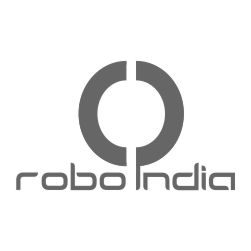This tutorial of Robo India explains how to control the speed and direction of DC motor with Double H Bridge Motor Driver Module.
1. Introduction
The Double H Bridge Motor Driver module is based on L298N chip manufactured by ST semiconductor.
It is a high voltage and high current full dual bridge driver designed to accept standard TTL logic level and drive inductive loads such as relays, solenoids and DC stepper motor.

1.1 Specification:
1. Chip: L298N (ST).
2. Logical Voltage: 5V
3. Driving Voltage: 5V – 35V.
4. Logical Current: 0mA – 36mA.
5. Driving Current: 2A.
6. Maximum Power: 25W.
1.2 Working:
Enable A, Input Pin 1 and 2 is to control the output 1 and 2.
Enable B, Input Pin 3 and 4 is to control the output 3 and 4.
A jumper is preset on ENA and ENB pin, so that motor will be enable and work with their maximum speed. and when you want to control speed of rotating motors, remove that preset jumpers.
Another jumper is preset on +12V pin, to supply 5V power to other components of module.

2. Hardware required
| S.No. | Item | Quantity |
| 1 | Arduino UNO | 1 |
| 2 | Double H Bridge Motor Driver | 1 |
| 3 | DC Motor | 2 |
| 4 | Female to Male Jumper wire | 7 |
| 5 | 6xAA Battery | 1 |
3. Connection:

with PWM Signals:

4. Programming:
You may download this code (Arduino Sketch) from here.
//Tutorial by RoboIndia on L298N Double H Bridge Motor Driver Module
//https://www.roboindia.com/tutorials/
int IN1 = 10; //Motor B
int IN2 = 9;
int IN3 = 8; //Motor B
int IN4 = 7;
void setup()
{
// Set the output pins
pinMode(IN1, OUTPUT);
pinMode(IN2, OUTPUT);
pinMode(IN3, OUTPUT);
pinMode(IN4, OUTPUT);
}
void loop()
{
// Rotate the Motors clockwise
digitalWrite(IN1, HIGH);
digitalWrite(IN2, LOW);
digitalWrite(IN3, HIGH);
digitalWrite(IN4, LOW);
delay(2000);
// Rotate the Motors Anticlockwise
digitalWrite(IN1, LOW);
digitalWrite(IN2, HIGH);
digitalWrite(IN3, LOW);
digitalWrite(IN4, HIGH);
delay(2000);
}
You may download this code (Arduino Sketch) with PWM Signals from here.
//Tutorial by RoboIndia on L298N Double H Bridge Motor Driver Module using PWM Signals
//https://www.roboindia.com/tutorials/
int IN1 = 10; //Motor A
int IN2 = 9;
int IN3 = 8; //Motor B
int IN4 = 7;
//needs to be PWM pin to control speed
int EN1 = 11; // Pin 1 of L293D IC
int EN2 = 6; // Pin 9 of L293D IC
void setup()
{
pinMode(EN1, OUTPUT); // where the motor is connected to
pinMode(EN2, OUTPUT); // where the motor is connected to
pinMode(IN1, OUTPUT);
pinMode(IN2, OUTPUT);
pinMode(IN3, OUTPUT);
pinMode(IN4, OUTPUT);
Serial.begin(9600);
Serial.println("Enter values between 0 - 255");
}
void loop()
{
if(Serial.available())
{
int speed = Serial.parseInt(); //Receive Value from serial monitor
Serial.println(speed);
analogWrite(EN1, speed); //sets the motors speed
analogWrite(EN2, speed); //sets the motors speed
digitalWrite(IN1, HIGH);
digitalWrite(IN2, LOW);
digitalWrite(IN3, HIGH);
digitalWrite(IN4, LOW);
}
}
5. Output
After the connection you will copy and paste this code in Arduino IDE than upload the code.
The output of the first code is both connected motor will start rotating clockwise and then anticlockwise for 2 sec.
To get output of second code, Open the Serial Monitor and send the input values to Arduino. You can control the speed of the DC motor by sending different values between 0 -255.

If you have any query please write us at support@roboindia.com
Thanks and Regards
Content Development Team
Robo India
https://roboindia.com
